Seat’s investment in supply chain visibility and logistics automation has helped it to better manage the disruption caused by the coronavirus. Marcus Williams talks to Juan Vivas, inbound manager at the carmaker’s plant in Martorell
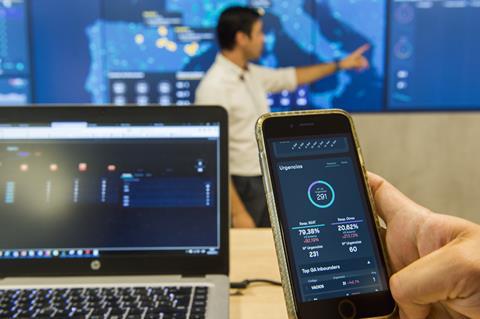
Well before coronavirus became top of everyone’s mind, Seat had been implementing a range of supply chain and logistics technologies at its Martorell plant near Barcelona, on Spain’s west coast, that supported better control, planning and handling of parts and material in its supply chain.
These systems – including automated storage and handling, control towers, apps and drones – together with communication with suppliers and across the Volkswagen Group, have helped Seat to restart production and to avoid a single stoppage as a result of material shortages, according to Juan Vivas, inbound manager of the Martorell plant (see interview below).
In 2018, for example, Seat opened a major automated logistics centre covering a total area of 5,700 sq.m divided into two facilities – including the tallest warehouse in Spain at 43.7 metres high – which store and feed inbound parts to the Martorell assembly line. The larger facility can store 24,000 containers of larger parts across seven aisles, moving 500 of them an hour to the plant. The second (21 metres high) stores more than 95,000 boxes of smaller parts across five aisles. It will move 1,100 of these to the plant every hour, according to the carmaker.
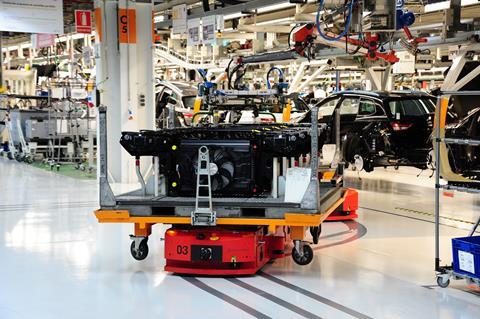
Some of the more recent developments at Martorell include a supply chain control tower to manage the real-time location of more than 16m parts fitted every day when the plant is at full capacity production (last year it made more than 500,000 cars). The control tower has also played its part in managing inventory during the crisis caused by the coronavirus pandemic (see interview with Martorell’s inbound manager, Juan Vivas, below).
A key feature of the control tower is a videowall divided into different screens displaying constantly updated numbers, graphs and maps, with itineraries and codes that correspond to the material and supply flow to the plant. An associated app monitors the exact location of each part in connection with production needs. Installed in October 2019, it is the first time that Seat has had real-time information on the flow of material, transit operation alerts and production material consumption.
With around 200,000 core figures updated daily, the resulting data forms the basis for predictive tools to solve incidents before they occur, according to the company.
Juan Vivas, inbound manager at Seat Martorell, talks about the challenges to inventory management at Martorell brought about by the coronavirus pandemic

What were the immediate challenges in terms of inventory management of the shutdown in production SEAT’s plants across Europe?
To scope all the suppliers worldwide. Managing the best information on real time about their manufacturing status has been a challenge that could be managed by usual tools and some extra effort.
The current challenge we must deal with is to have the necessary overview at the whole supply chain, not only first tier suppliers, but also other second and third tier suppliers that have influence on the production of our suppliers, and therefore on our own.
How did you cope with those challenges and what part did digital technology play?
The overview on the transport network for each supplier’s location can be provided by today’s digital technology. Dealing with and comparing a huge amount of information, coming from suppliers and from the Volkswagen Group, has been a field where Big Data tools can be helpful in terms of efficiency, and in order to focus the attention on analysing and managing alternatives and solutions.
How did that compare with the challenges of restarting production and securing the adequate supply of parts given the shutdowns at the tier suppliers?
This is a consequence of the points above. By having the best on-line information about what was happening on the supply chain, we could handle and evaluate different situations.
Was the company forced to find overflow facilities to store parts arrested at different stages in the supply chain? Can you provide examples?
The main problem was not only to find the facilities to store the parts but also how to transport them. We were not the only company having this challenge, it was worldwide. Therefore, resources were minimised, and we had to become as flexible as ever, doing exhaustive follow ups of materials and being as precise as possible.
What percentage of the parts inbound were from markets outside Europe? Did this present different problems and, if so, how were they dealt with?
Inbound parts from outside Europe are a normal aspect of today’s automotive production. From a supply chain point of view, this is a standard situation.
The challenge here is how to have the best online information, directly and reliable, from each location. The support of the European headquarters of the overseas suppliers, as well the coordination with the Volkswagen Group, have provided Seat a high value.
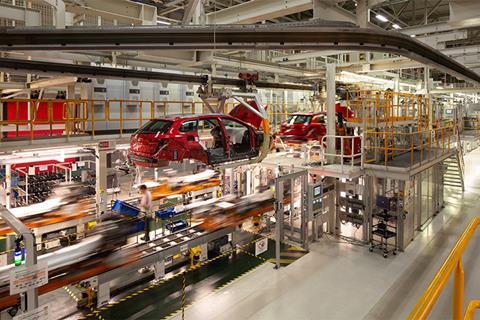
Are there any complex parts or assemblies that posed particular problems as the supply chain came to a standstill?
The pieces that were mainly affected by the shutdowns were the ones with higher complexity. Those modules could have a lot of components from all over the world, so as global plants shut down, each time it was more difficult to handle all these components. We had to become more flexible, thinking out of the box to find new solutions or try to find new ways to supply materials.
How did your main logistics providers assist in finding solutions to the disruption caused and can you detail any specific examples?
The only way to handle a disruption of this magnitude was to be completely transparent. That was the difference between success or failure. Therefore, from minute one we contacted and requested that our main providers give us as much detail and live information about components shortages, or other inputs from all over the world. With this we created a team with our providers to try to find different solutions to reduce the impact on our production.
As a specific example, when the crisis first started to unfold in China, there was a complete uncertainty about how it would all evolve. I asked my team to reach out to our main suppliers to review stocks and components coming specifically from China. We created a daily task force reviewing any possible issue, thinking about possible solutions or alternatives.
Likewise, in what ways was Seat able to work with its tier suppliers in managing inventory both during the sudden shutdown of inbound supply and in its restart?
We tried to increase our safety stock, not only for a possible lack of material but also in case there was a complete shutdown, so we would have enough material to guarantee a safe and smooth restart. All this was possible thanks to the cooperation that we have with our providers. We identified the critical cases and tried to optimise the resources of materials and components as much as possible.
We all had a very clear premise of what to do in case we stopped. Once we restarted, our objective was not to stop again for lack of material. This goal was shared with our providers and together so far, we have made it work.
How has the company’s management of inventory changed since the crisis?
[We made] the deepest overview of the supply chain [and provided] the best control provided over it. We are absolutely committed to the digital tools, as seen in the development of our supply chain control tower. The current crisis has reinforced our commitment. It is our base for the management of inventory, but it will also be the way to put the logistic supply chain and market expectations together.
Ground-to-air logistics
In another application, Seat is now using drones routinely to deliver steering wheels and airbags at Martorell, following initial trials carried out early last year. The components are being flown 2km from a warehouse in Abrera run by logistics provider Grupo Sesé. The drone flies autonomously at a height of 95 metres over the factory roof at 40 km/hour.
It takes just four minutes from take-off until the capsule is dropped off at its destination, while the complete process lasts 15 minutes from activating the order. Trucks take an average of 90 minutes for the same delivery.
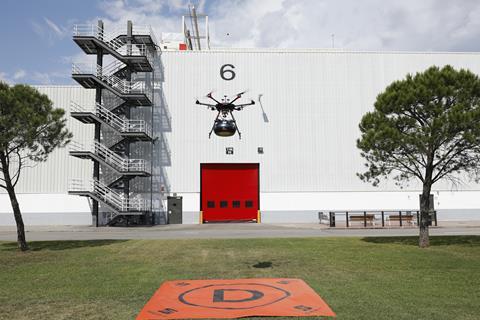
Furthermore, just prior to the shutdown caused by the coronavirus in March, the carmaker began to use automated guided vehicles (AGVs) with a simultaneous localisation and mapping navigation system (known as a Slam) for outdoor deliveries within the Martorell complex. Since May, after production restarted, it has been rolling the AGVs out again.
Each outdoor AGV pulls attached carriages makes up a 25-metre convoy with a maximum payload of ten tonnes covering routes of 3.5 km.
Altogether, the eight AGVs operating at Martorell travel 240km a day on two routes between the press and metal shops, where parts such as hatches and doors are delivered.
The AGVs make deliveries more efficient and cost effective, according to Seat, reducing stockpiling at both the starting and destination points, and cutting down on traffic inside the factory.
Thanks to the Slam navigation, the vehicles are not guided by magnetic tape or wires, as is often the case in warehouses and industrial sites. Instead, the AGVs navigate their route by using a map they generate through software, algorithms and sensory information.
Deployment of vehicles using Slam requires no construction, maintenance costs are reduced, the AGVs are more versatile and they can adapt to new routes, according to Seat.
In July this year, Seat also launched its smart factory training project for production line workers called the Industry 4.0 Academy. The project aims to provide operators with the skills to meet the demands of the digital factory and currently 80 workers are participating in the pilot programme. The programme consists of five modules: Digital Factories, Manufacturing Technologies, Electric Mobility, Industrial Organisation and Soft Skills. Each module lasts three months during which students spend an average of eight hours a week, outside working hours.
One year of Seat:Code
In July this year Seat celebrated the first birthday of its Seat:Code software development division with a relocation to the centre of Barcelona, at Rambla 124.
Seat:Code was set up to drive the carmaker’s digital transformation and increase efficiency through process digitalisation, according to the company. It focuses on production, logistics, marketing and sales, including the creation of digital solutions to enhance Seat, Cupra and Seat Mó products, as well as defining digital solutions for the Volkswagen Group.
During the height of the coronavirus pandemic in Europe it also developed a digital logistics tool for the production and distribution of emergency ventilators manufactured by Seat.
“Seat:Code is not only a strategic and transversal pillar to improve the efficiency by advancing the digitalisation of our company and processes, but it also allows us to develop new digital products to create additional business for Seat going beyond the car,” says Sebastian Grams, chief information officer (CIO) at the carmaker.
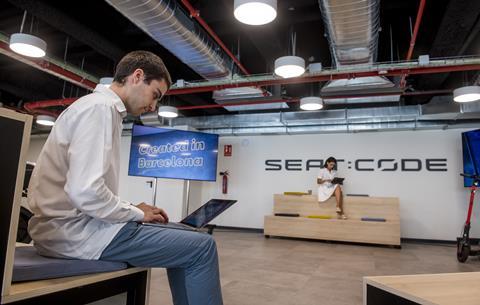

























![Global[1]](https://d3n5uof8vony13.cloudfront.net/Pictures/web/a/d/s/global1_726550.svgz)













No comments yet